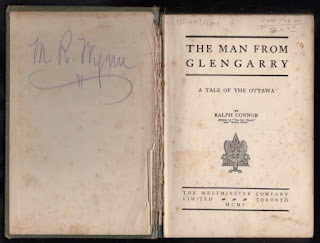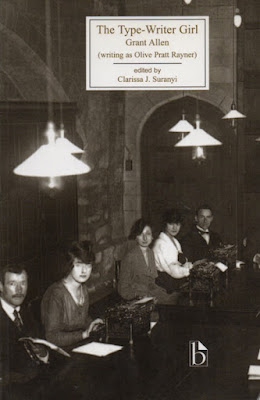A Voice is Calling
Eric Cecil Morris
Montreal: B.D. Simpson, 1945
487 pages
The strangest novel I've read this year, I struggled to make time for A Voice is Calling between reference materials for my next book. This distraction may explain why it wasn't until late in the book that I remembered its prologue. In my defence, the scene depicted is uneventful: A middle-aged man and young girl enter a Montreal barber shop. A paperboy delivers a copy of the Gazette, and talk turns to the news that Andre Brousseau, wanted in the deaths of six people, has himself been found dead.
Still, I shouldn't have forgotten, because Andre Brousseau is the protagonist of this strange novel. His past is something of a mystery. An architect by training, Andre once worked in Quebec City, but something happened that made him quit both the profession and the city. Prologue aside, the novel opens with the poor sod working away as a lumber company clerk in the fictitious town of Trois Lupins. As a sophisticated city boy, he had attracted and married Suzanne Cote, the prettiest girl in town. It was her now-deceased father who got him the job. Fifteen years have passed – more than enough time to put to rest any idea Suzanne had that her husband will make something of himself. The couple have settled into a routine in which Suzanne nags him to remove his boots when arriving home from work. At the end of a particularly memorable workday, Andre brings news that his boss, M Lalonde, is transferring him to the Gaspé village of Ste Michele, where he will oversee lumber orders in the construction of a new factory. Suzanne, who once dreamed of Quebec City – and even Montreal – can't bear the thought. She confronts Lalonde in his office... and comes away defeated.
Unbeknownst to Andre, Suzanne and Lalonde have been having an affair. She's now pregnant with his child and the boss wants her out of the way. The story Lalonde gives his clerk involves Ste Michele's new church, built in anticipation of the influx of factory workers. Andre will be expected to play the organ on Sundays.
There's no exaggeration in writing that Andre lives for the organ. His love for Suzanne is dead. Though he does love Anne, their only child, it's not nearly with the depth one might expect of a father. No, his passion is invested in the organ and, with near-exclusivity, the music of Johann Sebastian Bach. Something can probably be read into the fact that he keeps the great man's music underneath the marital bed.
The Brousseau family's arrival in Ste Michele is not a happy one. The village is much smaller and less refined than Trois Lupins – as is the house found for them by the parish priest – and the winter weather is miserable. Suzanne spends the better part of her days in bed crying, while twelve-year-old Anne attends to her needs. Andre, on the other hand, settles in quite nicely. He finds a loyal friend and confident in goodnatured neighbour Lawrence Nixon, a cultured Englishman who has taken refuge in the Gaspé after having suffered some sort of tragedy.
Dust jacket copy describes A Voice is Calling as "a book for everyone – for those who like romances, thrills and adventure, for lovers of music, but most particularly for the countless thousands of readers who like a good, strong, interesting plot that will hold their attention on every page." To the point of Andre's budding friendship with Lawrence, the book held my attention, but this had more to do with it being something of a curiosity. Not many English-language Canadian novels feature French Canadian protagonists, and I can't think of another set in the Gaspé.
Then the novel took a very strange turn.
One evening, while playing the organ alone in the church, Andre senses a ghostly presence. This frightens him, but not so much that he doesn't return. He comes to believe that Bach is guiding his hands in performance. And then, on a later evening, a figure appears in coat, flowered waistcoat: "I am a friend of your's Andre Brousseau – you know me very well, said the man, in a deep quiet voice, "I am Johann Sebastian Bach."
In order to allay skepticism, the composer invites Andre to visit his afterlife, which is an idealized version of 1735 Leipzig. Once there, the lumber company clerk is treated to a chamber performance by members of the Bach family and falls in love with his host's dark-eyed daughter Katherina. He returns to twentieth-century Ste Michele intent on seeing her as much as possible, but doesn't want to press his welcome. Drama ensues when Suzanne attempts to abort the baby. Her departure by ambulance to a hospital in Rimouski fairly coincides Andre's discovery by two members of Montreal's Casavant Society, and an invitation to perform at Montreal's ill-fated First Unitarian Church.
 |
| First Unitarian Church, Montreal 27 May 1987 |
I won't reveal more for fear of spoiling things.
Or have I already?
Not as much as the prologue.
Trivia: Catharina Dorothea Bach was the first of the composer's twenty children. Morris errs in spelling her name "Katharina."
Dedication:
A bonus:
Object: An attractive, bulky book in navy blue boards. The dust jacket is by C.W. MacDonald.
Access: Held by Library and Archives Canada, Bibliothèque et Archives nationales du Québec, and sixteen of our university libraries.
Four copies are currently listed for online. The good news is that they're going cheap, ranging in price from US$5 ("lightly rubbed," lacking dust jacket) to US$23 (Very Good in Very Good dust jacket). I purchased my copy in 2017 from a bookseller in Tacoma, Washington. Price: US$13.50.
Translated by Martine Hébert-Duguay as Le dernier voyage: Un roman de la Gaspésie (Montreal: Chanteclerc, 1951), the subject of next week's post.
Related posts:
Bach to the Future, Part II: Le dernier voyage
Bach to the Future, Part III: The Squeaking Wheel
Tan Ming's Disappointing Post-Apocalyptic World
Bach to the Future, Part III: The Squeaking Wheel
Tan Ming's Disappointing Post-Apocalyptic World



























































